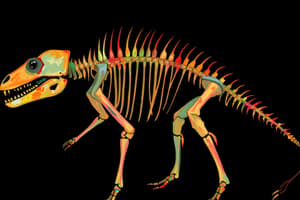Podcast
Questions and Answers
What is the primary characteristic that distinguishes vertebrates from other animals?
What is the primary characteristic that distinguishes vertebrates from other animals?
- Presence of a tail
- Presence of a heart
- Presence of a brain
- Presence of a backbone or vertebral column (correct)
Which of the following classes of vertebrates is characterized by the presence of feathers?
Which of the following classes of vertebrates is characterized by the presence of feathers?
- Aves (correct)
- Reptilia
- Mammalia
- Pisces
What is the primary difference between endothermic and ectothermic vertebrates?
What is the primary difference between endothermic and ectothermic vertebrates?
- Type of skeleton
- Body structure
- Ability to regulate body temperature (correct)
- Skin type
Which of the following is NOT a characteristic of vertebrates?
Which of the following is NOT a characteristic of vertebrates?
What is the main grouping used to classify vertebrates?
What is the main grouping used to classify vertebrates?
Which of the following classes of vertebrates is characterized by the presence of scales?
Which of the following classes of vertebrates is characterized by the presence of scales?
What is the verb form used for all subjects except the third person singular in the Present Simple tense?
What is the verb form used for all subjects except the third person singular in the Present Simple tense?
What is the verb ending used for the third person singular in the Present Simple tense?
What is the verb ending used for the third person singular in the Present Simple tense?
What is formed by adding -ing to the base form of the verb?
What is formed by adding -ing to the base form of the verb?
What is used in combination with the auxiliary verb 'to be' to form the Present Continuous tense?
What is used in combination with the auxiliary verb 'to be' to form the Present Continuous tense?
What agrees with the subject in number in the Present Continuous tense?
What agrees with the subject in number in the Present Continuous tense?
Which form is used for all subjects in the Present Continuous tense?
Which form is used for all subjects in the Present Continuous tense?
Flashcards are hidden until you start studying
Study Notes
Vertebrates
Definition
- Vertebrates are animals with a backbone or vertebral column
- Characterized by the presence of a spinal cord and a cranium (skull)
Characteristics
- Bilateral symmetry
- Segmented body
- Body cavity (coelom) present
- Nervous system present
- Muscular system present
- Endoskeleton (internal skeleton) made up of bone or cartilage
Classes of Vertebrates
- Mammalia (Mammals)
- Warm-blooded (endothermic)
- Hair or fur present
- Mammary glands present
- Examples: humans, dogs, cats, bears
- Aves (Birds)
- Warm-blooded (endothermic)
- Feathers present
- Lay eggs
- Examples: chickens, eagles, sparrows, robins
- Reptilia (Reptiles)
- Cold-blooded (ectothermic)
- Scaly skin
- Lay eggs
- Examples: snakes, lizards, turtles, crocodiles
- Amphibia (Amphibians)
- Cold-blooded (ectothermic)
- Moist, smooth skin
- Lay eggs
- Examples: frogs, toads, salamanders, newts
- Pisces (Fish)
- Cold-blooded (ectothermic)
- Gills for respiration
- Scales present
- Examples: goldfish, sharks, tuna, salmon
Classification of Vertebrates
- Based on characteristics such as body structure, skin, and skeleton
- Vertebrates are divided into two main groups:
- Gnathostomata (jawed vertebrates)
- Agnatha (jawless vertebrates)
- Further classification is based on the presence or absence of limbs, skin, and other characteristics.
Vertebrates
Definition
- Vertebrates are defined by the presence of a backbone or vertebral column and a spinal cord enclosed in a cranium (skull)
Characteristics
- Exhibits bilateral symmetry
- Has a segmented body
- Possesses a body cavity (coelom)
- Has a nervous system and a muscular system
- Has an endoskeleton (internal skeleton) made up of bone or cartilage
Classes of Vertebrates
Mammals
- Warm-blooded (endothermic)
- Possess hair or fur
- Have mammary glands
- Examples: humans, dogs, cats, bears
Birds
- Warm-blooded (endothermic)
- Have feathers
- Lay eggs
- Examples: chickens, eagles, sparrows, robins
Reptiles
- Cold-blooded (ectothermic)
- Have scaly skin
- Lay eggs
- Examples: snakes, lizards, turtles, crocodiles
Amphibians
- Cold-blooded (ectothermic)
- Have moist, smooth skin
- Lay eggs
- Examples: frogs, toads, salamanders, newts
Fish
- Cold-blooded (ectothermic)
- Have gills for respiration
- Have scales
- Examples: goldfish, sharks, tuna, salmon
Classification of Vertebrates
- Classified based on characteristics such as body structure, skin, and skeleton
- Divided into two main groups:
- Gnathostomata (jawed vertebrates)
- Agnatha (jawless vertebrates)
- Further classification is based on the presence or absence of limbs, skin, and other characteristics
Verb Forms in Present Simple and Present Continuous Tenses
Present Simple
- Base form of the verb is used for all subjects except the third person singular (he, she, it).
- Examples: I/you/we/they go, he/she/it goes.
- Third person singular form ends in -s or -es.
Present Continuous
- Present participle is formed by adding -ing to the base form of the verb.
- Examples: go -> going, write -> writing.
- Present participle is used for all subjects, with the auxiliary verb "to be" agreeing with the subject in number.
- Examples: I am writing, you are writing, he/she/it is writing, we are writing, they are writing.
- Present participle is used in combination with the auxiliary verb "to be" to form the present continuous tense.
Studying That Suits You
Use AI to generate personalized quizzes and flashcards to suit your learning preferences.




